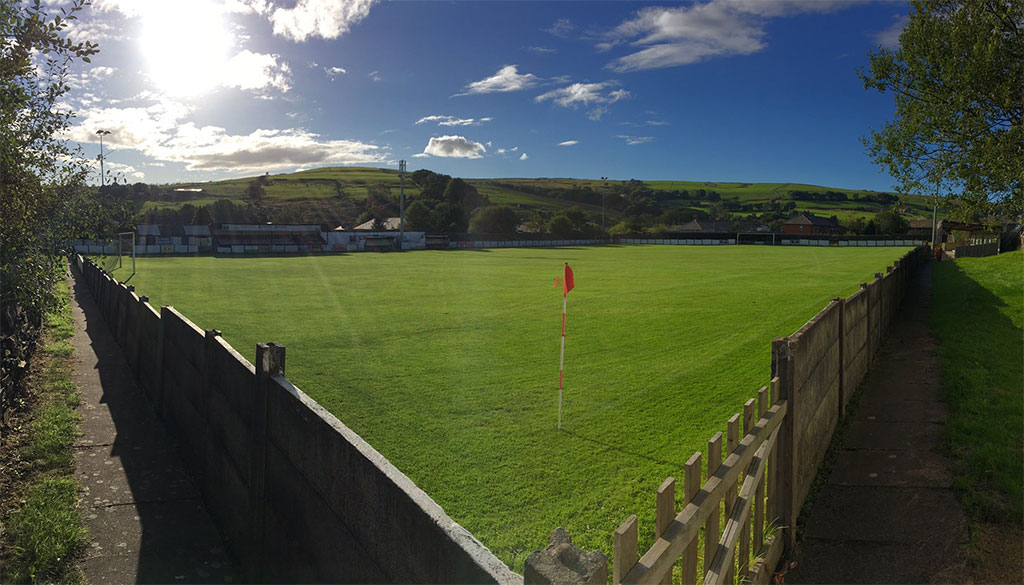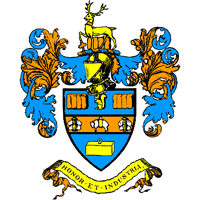
Emblematically Speaking - Bacup Borough
Tue 17th October 2017 | Bacup Borough | By Stewart Taylor
This week we return to the idea of a football club representing its town by the adoption of the town coat of arms as the club emblem.
Here we see the coat of arms of Bacup and, as is usually the case with heraldic coats of arms, it is bursting with information relevant to the town.
To many, the history of the Lancashire towns are inextricably linked with industry and, specifically, the textile industry. That link to the textile industry remains very strong although most if not all of the previously dominant cotton industry has died away.
However, the towns did exist before King Cotton came along although with much lower populations than in their heyday. The town coat of arms, granted in 1883, reflects a little of what Bacup was like before and after the industrial revolution.
The early reference comes from the incorporation of a stag (in the crest) and a squirrel (on the arms) which represent the Forest of Rossendale, now perhaps better known as the Rossendale Valley and counting Bacup, Haslingden and Rawtenstall as the principal settlements along the banks of the River Irwell and its tributaries.
One of the earliest sites of historical interest in the valley is that of the dykes at Broadclough, which are associated with the Battle of Brunanburh. Rossendale was governed by a constable nominated by principal landowners who held the position of "The Greave of The Forrest" which, after 1515, became a quasi-hereditary position held by the Whittaker (Whitacker) family.
Their home was the only ancient hall in the district: Broadclough Hall, situated on Burnley Road, Bacup and now Grade II Listed. The current building dates back to around 1855 and was built on the site of two previous halls which carried the same name.
Later, the valley was part of the medieval Forest of Rossendale. Settlement in late Middle Ages would have been in "booths" or farmsteads and encroachment into the forest would have developed them into small hamlets.
The Whittaker family owned at least 50 farms in the area, principally on the hillsides around Bacup and the Lumb Valley. Houses known as the Club Houses and many of the shops between Rochdale Road and Newchurch Road belonged to the family.
The rapid growth in the cotton industry in Lancashire was helped with the natural landscape providing water supply to power machines and plenty of suitable stone available for construction.
The coat of arms alludes directly to this with the incorporation of a fleece and cotton bales to represent the textile industry and a block of stone to represent quarrying. It is perhaps of interest to note that the flagstones in Trafalgar Square in London were quarried in Rossendale.
Whilst we have made previous note of the significance of the textile industry to our local towns, quarrying was of considerable relevance here with sources estimating that up to 3000 men were employed in quarrying in the Rossendale Valley in the peak period at the latter half of the 19th century. The relevance of these dates will not be lost if considered in the context of the Cotton Famine.
The motto 'HONOR ET INDUSTRIA' (Latin) translates as honour and industry which finds representation in the coat of arms in the form of two bees.
Recent events in Manchester have focussed on the bee as a symbol of the city but the use of a bee to represent industry is much more widespread and goes back quite some time.
Devotees of the legendary (gets in yer bones) Boddingtons Bitter, as made at the Strangeways Brewery in Central Manchester, may well recall that two bees were part of the logo of the brewery. But just a note of warning, the current Boddingtons Bitter bears no relationship whatsoever to the original!
And just to conclude this piece, the Rossendale Valley has been claimed by a professor at the Manchester Metropolitan University to be a home to fairies. I think it wise if I let you be the judge of that!
(Our thanks to Roger Hindle and Brent Peters of Bacup for their help with this article).
 Emblematically Speaking - Bacup Borough
Emblematically Speaking - Bacup Borough
Tue 17th October 2017 | Bacup Borough
By Stewart Taylor

This week we return to the idea of a football club representing its town by the adoption of the town coat of arms as the club emblem.
Here we see the coat of arms of Bacup and, as is usually the case with heraldic coats of arms, it is bursting with information relevant to the town.
To many, the history of the Lancashire towns are inextricably linked with industry and, specifically, the textile industry. That link to the textile industry remains very strong although most if not all of the previously dominant cotton industry has died away.
However, the towns did exist before King Cotton came along although with much lower populations than in their heyday. The town coat of arms, granted in 1883, reflects a little of what Bacup was like before and after the industrial revolution.
The early reference comes from the incorporation of a stag (in the crest) and a squirrel (on the arms) which represent the Forest of Rossendale, now perhaps better known as the Rossendale Valley and counting Bacup, Haslingden and Rawtenstall as the principal settlements along the banks of the River Irwell and its tributaries.
One of the earliest sites of historical interest in the valley is that of the dykes at Broadclough, which are associated with the Battle of Brunanburh. Rossendale was governed by a constable nominated by principal landowners who held the position of "The Greave of The Forrest" which, after 1515, became a quasi-hereditary position held by the Whittaker (Whitacker) family.
Their home was the only ancient hall in the district: Broadclough Hall, situated on Burnley Road, Bacup and now Grade II Listed. The current building dates back to around 1855 and was built on the site of two previous halls which carried the same name.
Later, the valley was part of the medieval Forest of Rossendale. Settlement in late Middle Ages would have been in "booths" or farmsteads and encroachment into the forest would have developed them into small hamlets.
The Whittaker family owned at least 50 farms in the area, principally on the hillsides around Bacup and the Lumb Valley. Houses known as the Club Houses and many of the shops between Rochdale Road and Newchurch Road belonged to the family.
The rapid growth in the cotton industry in Lancashire was helped with the natural landscape providing water supply to power machines and plenty of suitable stone available for construction.
The coat of arms alludes directly to this with the incorporation of a fleece and cotton bales to represent the textile industry and a block of stone to represent quarrying. It is perhaps of interest to note that the flagstones in Trafalgar Square in London were quarried in Rossendale.
Whilst we have made previous note of the significance of the textile industry to our local towns, quarrying was of considerable relevance here with sources estimating that up to 3000 men were employed in quarrying in the Rossendale Valley in the peak period at the latter half of the 19th century. The relevance of these dates will not be lost if considered in the context of the Cotton Famine.
The motto 'HONOR ET INDUSTRIA' (Latin) translates as honour and industry which finds representation in the coat of arms in the form of two bees.
Recent events in Manchester have focussed on the bee as a symbol of the city but the use of a bee to represent industry is much more widespread and goes back quite some time.
Devotees of the legendary (gets in yer bones) Boddingtons Bitter, as made at the Strangeways Brewery in Central Manchester, may well recall that two bees were part of the logo of the brewery. But just a note of warning, the current Boddingtons Bitter bears no relationship whatsoever to the original!
And just to conclude this piece, the Rossendale Valley has been claimed by a professor at the Manchester Metropolitan University to be a home to fairies. I think it wise if I let you be the judge of that!
(Our thanks to Roger Hindle and Brent Peters of Bacup for their help with this article).


